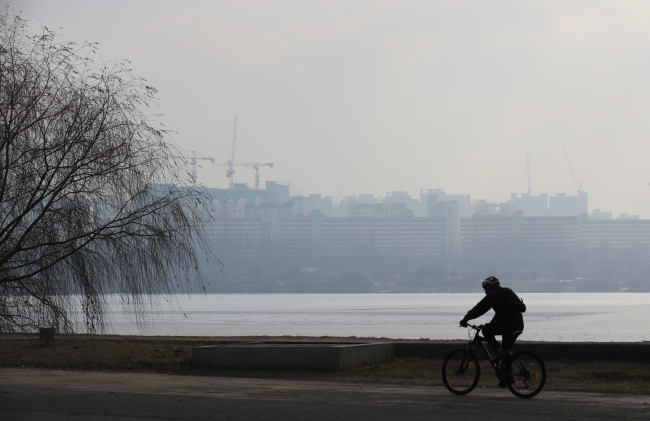Seoul’s free public transit program begins amid heavy fine dust
By Bak Se-hwanPublished : Jan. 15, 2018 - 14:33
Aimed at tackling the worsening air quality, the Seoul Metropolitan Government’s free public transport program went into effect Monday, the first time since its introduction last year. Fees for the subway and city buses were waived during commuting hours to encourage commuters to use public transit in an attempt to reduce vehicle emissions, as the daily average density of ultra-fine dust in the capital area was expected to remain above 50 micrograms until Tuesday.
Seoul is expected to spend 6 billion won ($5.65 million) per day to run the free transit service, with expectations of the number of public transportation users to increase 20 percent with free fares. The program is expected to run seven times a year, considering last year’s fine dust levels, according to the city.
The city also simultaneously shut down 360 parking lots at government buildings, suspending the use of the city’s 33,000 official vehicles allocated for special purposes.
Seoul is expected to spend 6 billion won ($5.65 million) per day to run the free transit service, with expectations of the number of public transportation users to increase 20 percent with free fares. The program is expected to run seven times a year, considering last year’s fine dust levels, according to the city.
The city also simultaneously shut down 360 parking lots at government buildings, suspending the use of the city’s 33,000 official vehicles allocated for special purposes.

Seoul -- home to roughly one-fifth of the country‘s 52 million people -- announced a package of measures to fight fine dust in July 2017, following public concerns over the government’s seemingly inadequate response to air pollution, which experts say will have adverse health impacts, especially on children.
Experts warn that the invisible dust particles, classified as harmful by the World Health Organization, penetrate into the respiratory system, causing a wide range of illnesses, including cancer.
Also separately, the Seoul Metropolitan Office of Education said it would notify elementary, middle and high schools in Seoul to refrain from outdoor activities when fine dust concentration levels exceed 50 micrograms per cubic meter and 25 micrograms per cubic meter for ultrafine dust, the education authority announced in April.
Last year, Seoul’s air quality index at one point exceeded 179 micrograms per cubic meter of fine dust, marking the second highest among other metropolitan cities in the world after New Delhi, India, according to AirVisual that measures pollutant levels.
Critics, however, question the efficacy of the city’s extensive anti-air pollution measures, as the majority of fine dust particles associated with the springtime yellow haze mainly come from the western deserts of China, forming domestic smog, according to some experts.
Nam Kyung-pil, governor of Gyeonggi Province, opted out of Seoul’s free transit program on high fine dust level days, saying the province “can’t use taxpayer money” without knowing how effective the measure would be.
“No measures have been taken to resolve air pollution caused by freight vehicles that are responsible for about 70 percent of the country’s air pollution. (The free transit program) is likely to reduce only 1 percent of the fine dust levels, while requiring the province to spend 36.7 billion won per year,” the governor said.
By Bak Se-hwan (sh@heraldcorp.com)








![[KH Explains] How should Korea adjust its trade defenses against Chinese EVs?](http://res.heraldm.com/phpwas/restmb_idxmake.php?idx=644&simg=/content/image/2024/04/15/20240415050562_0.jpg&u=20240415144419)










![[Today’s K-pop] Stray Kids to return soon: report](http://res.heraldm.com/phpwas/restmb_idxmake.php?idx=642&simg=/content/image/2024/04/16/20240416050713_0.jpg&u=)